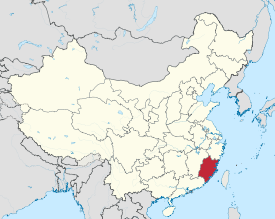Hokkian
|
Fujian Province 福建省 |
|
|---|---|
| Province | |
| Name transcription(s) | |
| • Chinese | 福建省 (Fújiàn Shěng) |
| • Abbreviation | simplified Chinese: ; traditional Chinese: (pinyin: Mǐn, Pe̍h-ōe-jī: Bân) |
| • Hokkien POJ | Hok-kiàn |
| • Foochow | Hók-gióng |
 Map showing the location of Fujian Province |
|
| Coordinates: 25°54′N 118°18′E / 25.9°N 118.3°ECoordinates: 25°54′N 118°18′E / 25.9°N 118.3°E | |
| Capital | Fuzhou |
| Largest city | Quanzhou |
| Divisions | 9 prefectures, 85counties, 1107townships |
| Government | |
| • Secretary | You Quan |
| • Governor | Yu Weiguo |
| Area | |
| • Total | 121,400 km2 (46,900 sq mi) |
| Area rank | 23rd |
| Population (2013) | |
| • Total | 37,700,011 |
| • Rank | 17th |
| • Density | 310/km2 (800/sq mi) |
| • Density rank | 14th |
| Demographics | |
| • Ethnic composition |
Han – 98% She – 1% Hui – 0.3% |
| • Languages and dialects | Min (inc. Hokkien dialects, Fuzhounese), Mandarin, Hakka |
| ISO 3166 code | CN-35 |
| GDP (2016) |
CNY 2.85 trillion USD 429 billion (11th) |
| • per capita |
CNY 74,288 USD 11,187 (7th) |
| HDI (2014) | 0.807 (high) (11th) |
| Website | www |
| Fujian | |||||||||||||||||||||||||||||||||||||||||||||||

"Fujian" in Chinese characters
|
|||||||||||||||||||||||||||||||||||||||||||||||
| Chinese | 福建 | ||||||||||||||||||||||||||||||||||||||||||||||
|---|---|---|---|---|---|---|---|---|---|---|---|---|---|---|---|---|---|---|---|---|---|---|---|---|---|---|---|---|---|---|---|---|---|---|---|---|---|---|---|---|---|---|---|---|---|---|---|
| Literal meaning | "Fu(zhou) and Jian('ou)" | ||||||||||||||||||||||||||||||||||||||||||||||
|
|||||||||||||||||||||||||||||||||||||||||||||||
| Abbreviation | |||||||||||||||||||||||||||||||||||||||||||||||
| Simplified Chinese | 闽 | ||||||||||||||||||||||||||||||||||||||||||||||
| Traditional Chinese | 閩 | ||||||||||||||||||||||||||||||||||||||||||||||
| Literal meaning | [the Min River] | ||||||||||||||||||||||||||||||||||||||||||||||
|
|||||||||||||||||||||||||||||||||||||||||||||||
| Transcriptions | |
|---|---|
| Standard Mandarin | |
| Hanyu Pinyin | Fújiàn |
| Bopomofo | ㄈㄨˊ ㄐㄧㄢˋ |
| Gwoyeu Romatzyh | Fwujiann |
| Wade–Giles | Fu2-chien4 |
| IPA | [fǔ.tɕjɛ̂n] |
| Wu | |
| Romanization | Foh-ji |
| Hakka | |
| Romanization | Fuk-kian |
| Yue: Cantonese | |
| Yale Romanization | Fūk-gin |
| IPA | [fók̚.kīːn] |
| Jyutping | Fuk1-gin3 |
| Southern Min | |
| Hokkien POJ | Hok-kiàn |
| Eastern Min | |
| Fuzhou BUC | Hók-gióng |
| Pu-Xian Min | |
| Hinghwa BUC | Ho̤h-ge̤̍ng |
| Northern Min | |
| Jian'ou Romanized | Hŭ-gṳ̿in.g |
| Transcriptions | |
|---|---|
| Standard Mandarin | |
| Hanyu Pinyin | Mǐn |
| Bopomofo | ㄇㄧㄣˇ |
| Gwoyeu Romatzyh | Miin |
| Wade–Giles | Min3 |
| IPA | [mìn] |
| Yue: Cantonese | |
| Yale Romanization | Máhn |
| Jyutping | Man5 |
| Southern Min | |
| Tâi-lô | Bân |
| Eastern Min | |
| Fuzhou BUC | Mìng |
| Pu-Xian Min | |
| Hinghwa BUC | Máng |
| Northern Min | |
| Jian'ou Romanized | Mâing |
Fujian (Chinese: ; pinyin: Fújiàn; pronounced [fǔtɕjɛ̂n]), formerly romanised as Foken, Fouken, Fukien, and Hokkien, is a province on the southeast coast of mainland China. Fujian is bordered by Zhejiang to the north, Jiangxi to the west, and Guangdong to the south. The name Fujian came from the combination of Fuzhou and Jianzhou (a former name for Jian'ou) two cities in Fujian, during the Tang dynasty. While its population is chiefly of Han origin, it is one of the most culturally and linguistically diverse provinces in China.
Most of Fujian is administered by the People's Republic of China (PRC). However, the archipelagos of Kinmen and Matsu are under the control of the Republic of China (ROC). Thus, there are two provinces (in the sense of government organizations): the Fujian Province administered by the PRC and the Fujian Province of the ROC.
Fujian Province, where most of the overseas Chinese in southeast Asia originated from, is still famously known as the Hokkien Province, based on the local pronunciation of the two Chinese characters "福建".
Recent archaeological discoveries demonstrate that Fujian had entered the Neolithic Age by the middle of the 6th millennium BC. From the Keqiutou site (7450–5590 BP), an early Neolithic site in Pingtan Island located about 70 kilometres (43 mi) southeast of Fuzhou, numerous tools made of stones, shells, bones, jades, and ceramics (including wheel-made-ceramics) have been unearthed, together with spinning wheels, a definitive evidence of weaving.
...
Wikipedia
